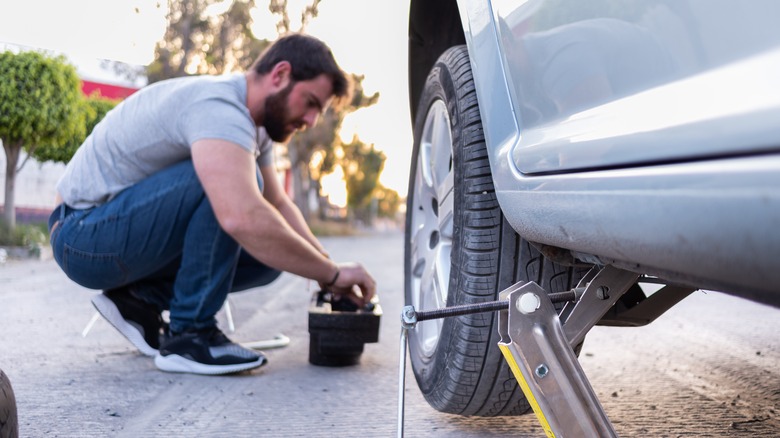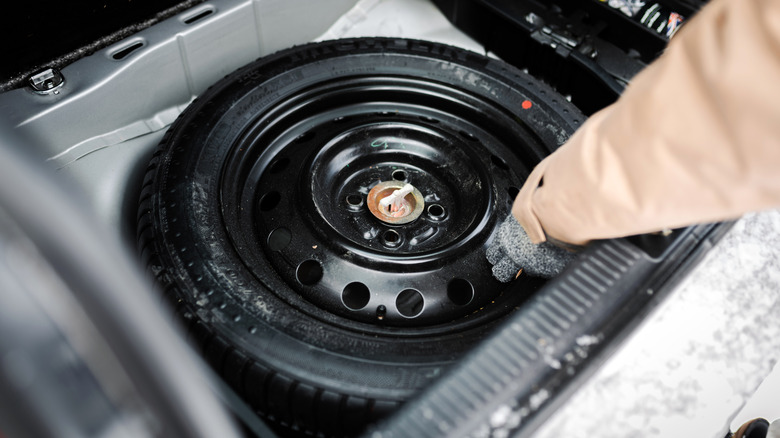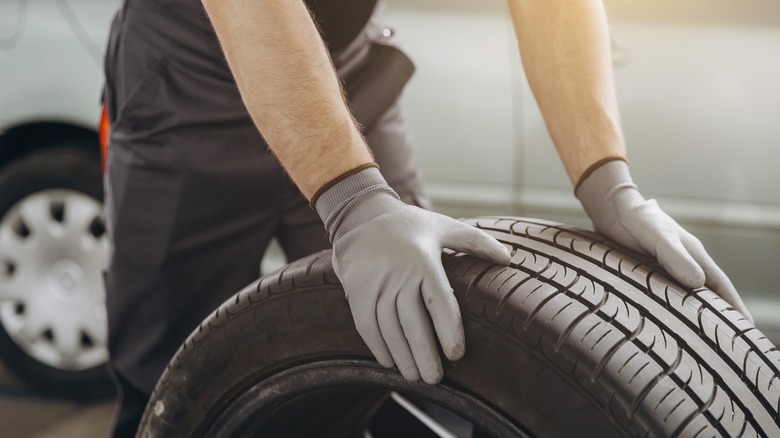The Pros & Cons Of Replacing Your Donut With A Full-Size Spare Tire
Dealing with a flat tire in the middle of nowhere is a common problem. It's good to carry these items you can carry in case you get a flat tire, as they keep you prepared for emergencies. Just having a can of Fix-a-Flat or a similar product provides a stopgap that will allow you drive at low speeds until you reach your destination or the nearest repair shop. A space-saving "donut" spare provides a similar temporary fix, albeit a longer-term and more confidence-inspiring solution. However, a full-size spare is still the best option since it is a true replacement for the damaged tire and allows you to continue driving without speed or distance restrictions.
Modern cars are increasingly sold without full-size spare tires, as automakers focus on reducing weight, improving fuel efficiency, and maximizing cargo space. According to Consumer Reports, only about 10% of new vehicles come equipped with a full-size spare as standard equipment. On the other hand, around 50% have compact donut spares. The rest make do with tire repair kits or run-flat tires or don't provide a solution for flat tires. If you currently have a donut as backup, you should know that upgrading to a full-size spare is an option. This switch offers several benefits, especially if you frequently travel long distances or rely on your car for daily commuting. However, this also comes with trade-offs. Before making the switch, be sure to weigh the advantages and disadvantages first to determine if switching to a full-size spare is the right choice for your vehicle and lifestyle.
The pros of replacing a donut with a full-size spare
One of the main benefits of switching to a full-size spare is improved safety and performance. As donuts are designed to be temporary solutions, they are typically rated for speeds of no more than 50mph and limited to an estimated travel distance of 50 miles. Continuing the journey beyond the limits could increase the risk of skidding, hydroplaning, or blowouts, thus putting your safety at risk. A full-size spare will let you drive without restrictions, and you won't have to worry about replacing the damaged tire right away. Driving on a donut spare can also cause issues for many all-wheel drive vehicles, so in this case you'll need to swap your space-saving spare for a full-size tire soon anyway. Another advantage is durability. Since donuts are thinner and made from less robust materials, they are more susceptible to damage, especially when driving through rough terrain or in adverse weather conditions.
Donuts are made for paved roads only, and subjecting them to uneven surfaces can lead to stability issues or damage the spare. A full-size spare is built the same as your stock tires. As such, it provides the same level of durability, even when driving in bad road conditions. Finally, switching to a full-size tire can save you money. Donuts wear out quickly as they are not designed for extended use. Hence, you might need to replace them more often, especially if you have suffered from a flat more than once. With a full-size spare, you can rotate the fifth wheel with the rest of the existing tires to extend the lifespan of the set. This can reduce tire replacement costs and help maintain balanced tread wear across all tires in the long run.
The cons of replacing a donut with a full-size spare
While swapping a donut with a full-size spare offers benefits, there are also downsides that you should consider before doing it. The most obvious drawback is the space required to make the switch. For many small cars, donuts are typically tucked in wheel wells underneath the cargo space. Meanwhile, some SUVs have an externally-mounted tire bracket on the rear cargo door to allow external carrying of a full-size spare. If you don't have such an external tire carrier, you'll need to check the well in the cargo area to make sure it can carry a full-size tire. Another downside is the increase in vehicle weight. Full-size tires are much heavier than donuts. Hence, carrying them around can affect fuel efficiency, vehicle handling, and performance. This is particularly true for smaller vehicles that are not designed to carry much of a load. Full-size spares can weigh 50 pounds or more, and automakers have embraced the easy weight savings for the sake of fuel economy.
Adding a full-size spare tire reverses this and increases long-term operating costs. Last but not the least is the cost of the switch. Full-size tires are more expensive than donut spares, and modifications may be necessary to accommodate the larger tire in many modern vehicles. Most high-quality spare tire mounting brackets or racks do not come cheap, and the additional expense may not justify the benefits of having a full-size spare, especially if you are on a tight budget.


